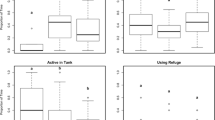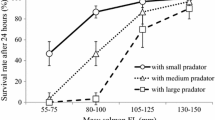Abstract
Feeding and growth responses of roach from three size classes to alarm substance (Schreckstoff) were quantified in laboratory experiments. Larger fish (60.0–80.0 mm in length) reacted stronger to treatment than two smaller sized groups (35.0–45.0 and 46.0–55.0 mm) lowering feeding rate by 80 and 40 and 50%, respectively. The reduction in feeding rate of larger fish caused decrease in growth rate in length and weight, while the lowered consumption of smaller fish caused only reduction in growth rate in weight. Condition factor of exposed to alarm substance small sized roach was lower than that of the control individuals and roach from other two size classes, both, treated and untreated. The difference in growth response to a danger of predation has its roots probably in different metabolism and growth rates of small and large fish. Small fish have higher metabolic rate and less lipid reserves than larger ones, therefore they are probably forced to feed to be able to grow. Also, small sized roach is more vulnerable to predation than large sized fish, thus growing fast seem to be crucial for survival in a risky environment. Study shows that small roach trade off their safety against food, feeding in risky environment to sustain fast growth. This ability of fast outgrowing of a dangerous, vulnerable to predators, size increases survival of juveniles in dangerous environment.
Similar content being viewed by others
References cited
Blaxter, J.H.S. & G. Hempel. 1963. The influence of egg size on herring larvae (Clupea harengus L.). J. Conseil Perm. Intern. Exploration Mer 28: 211–240.
Fuiman, L.A. & A.E. Magurran. 1994. Development of predator defences in fishes. Rev. Fish Biol. Fish. 4: 145–183.
Holopainen, I.J., J.A.M. Vornanen & H. Huuskonen. 1997. Phenotypic plasticity and predator effects on morphology and physiology of crucian carp in nature and in the laboratory. J. Fish Biol. 50: 781–798.
Irving, P.W. & A.E. Magurran. 1996. Context-dependent fright reaction in captive European minnows — the importance of naturalness in laboratory experiments. Anim. Behav. 53: 1193–1201.
Jobling, M. 1994. Fish bioeneregtics. Chapman & Hall, London. 455 pp.
Jachner, A. 1988. Growth of fry of three fish species from pelagial of mezotrophic lake. Pol. Arch. Hydrobiol. 36: 359–371.
Jachner, A. 1995. Changes in feeding behaviour of bleak (Alburnus alburnus L.) in response to visual and chemical stimuli from predators. Arch. Hydrobiol. 133: 305–314.
Jachner, A. 1996. Alarm reaction in bleak (Alburnus alburnus L. Cyprinidae) in response to chemical stimuli from injured conspecifics. Hydrobiologia 325: 151–155.
Jachner, A. 1997. The response of bleak to predator odour of unfed and recently fed pike. J. Fish Biol. 50: 878–886.
Pettersson, L.B. & C. Brönmark. 1993. Trading off safety against food: state dependent habitat choice in crucian carp. Oecologia 95: 353–357.
Russell-Hunter, W.D. 1970. Aquatic productivity: an introduction to some basic aspects of biological oceanography and limnology. Collier-Macmillan Ltd., London. 306 pp.
Savino, J.F. & R.A. Stein. 1989. Behaviour of fish predators and their prey: habitat choice between open water and dense vegetation. Env. Biol. Fish. 24: 287–293.
Smith, R.J.F. 1992. Alarm signals. Rev. Fish Biol. Fish. 2: 33–63.
Werner, E.E. & J.F. Giliam. 1984. The ontogenetic niche and species interactions in size-structured populations. Ann. Rev. Ecol. Syst. 15: 393–425.
Author information
Authors and Affiliations
Rights and permissions
About this article
Cite this article
Jachner, A., Janecki, T. Feeding and Growth Response of Roach, Rutilus rutilus, to Alarm Substance. Environmental Biology of Fishes 54, 433–437 (1999). https://doi.org/10.1023/A:1007523732293
Issue Date:
DOI: https://doi.org/10.1023/A:1007523732293




